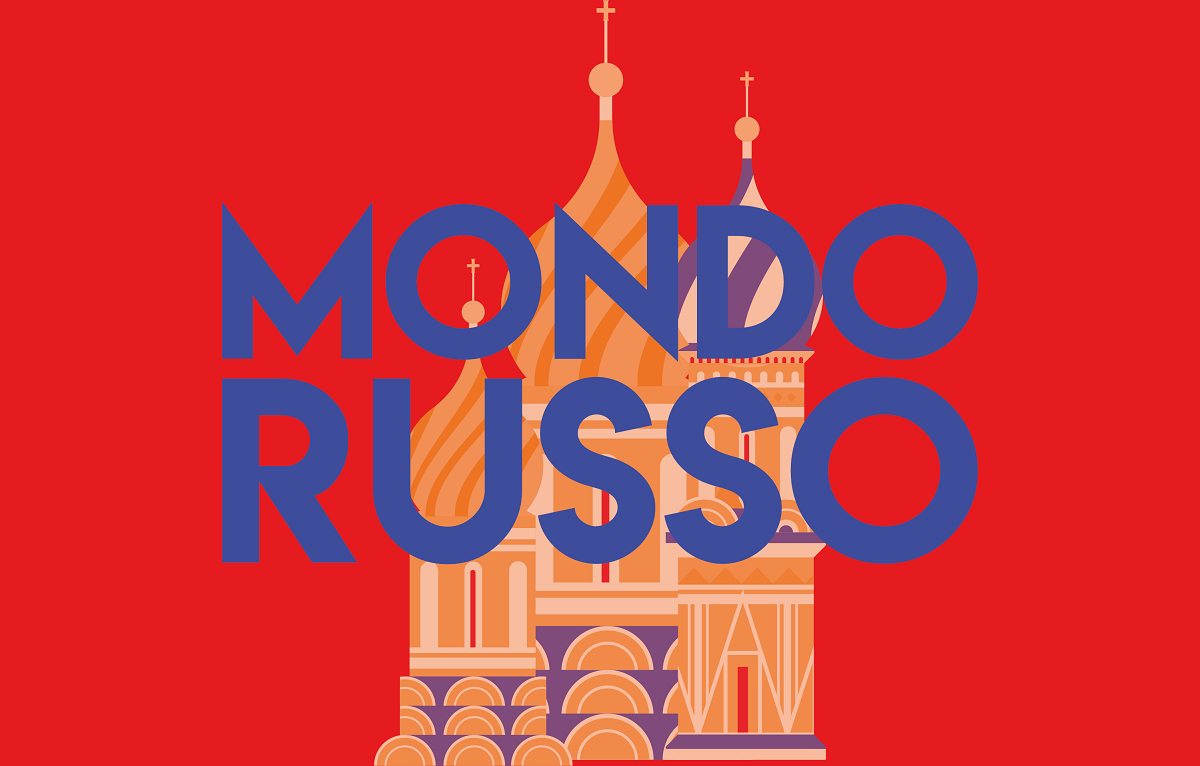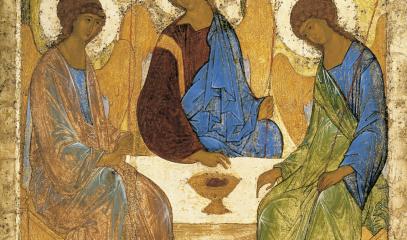The Russian invasion of Rublev’s Trinity
In order to prop up the spirit of Orthodox patriotism, Putin decided to return the famous icon to Kirill’s Church. It matters little if exposure in the Monastery of the Holy Trinity might turn it into dust. Using an icon to justify the sanctity of absolute power is by no means something new.
At the start of Putin's invasion of Ukraine, Russian Orthodox Patriarch Kirill said that, “This is a metaphysical war," far beyond its geographic and spiritual aspects.
After a year and three months of a gruelling and fruitless war, full of death and destruction that failed to enhance the greatness of the empire, Putin and Kirill have finally achieved their real goal and invaded the kingdom of heaven, occupying the space of the Holy Trinity.
In lieu of the Father and the Son we now have the Patriarch and the President, and the Holy Spirit is personified by the subjugated country: today it is Ukraine, yesterday it was Georgia, tomorrow it might Kazakhstan or Sudan, or any other hypostasis or substance underpinning the "Russian world".
A few months ago, the Icon of the Trinity by Andrei Rublev, the most famous sacred image in the Christian East, dating from the early 15th century, was used as the banner of holy war, when it was moved for a few days from Moscow’s Tretyakov Gallery to Saint Sergius Lavra (monastery) in Radonezh, prophet of the rebirth of Russia after the two centuries of Tartar yoke.
After the exhibit, curators and art critics put the sacred board under protection, because it had been damaged during the move, saying that it could not be exposed for at least three years. But as some say: “We defeated the Nazis, so we can defeat the specialists as well.”
A few days ago, Patriarch Kirill went back for one more treat, demanding the use of the icon to boost the spirit of Orthodox patriotism, which is currently waning after useless and devastating mobilisations are stretching the patience of ordinary Russians, even if they still appear to back the sacred struggles of the empire.
Putin outdid himself, deciding to return the Trinitarian image once and for all to the Church, to place it again in the place for which it was made, that is the Monastery of the Holy Trinity, 70 kilometres from Moscow where the saint’s remains rest, and where the faithful from all over the country incessantly prostrate themselves.
For this reason, the patriarch proposed to sing to the president the hymn Mnogaya leta (Многая лета), the Church Slavonic version of Ad multos annos, a very prophetic wish in view of next year's elections.
It matters not if exposure could turn the icon into dust. Alternatively, as some have suggested, it could "put directly in Lenin’s Mausoleum in Red Square and replace Lenin”. The building is already equipped with a lab specialised in keeping the dictator’s body in a state of "perennial purity", a grotesque puppet of a fake religion.
Once upon a time, the Mausoleum too was expended to become Trinitarian in its own way. The corpse of Stalin the Son was placed next to that of Lenin the Father, until the Holy Spirit of Khrushchev intervened, ending the Soviet liturgy of divinisation of power, turning the hallow crypt into to a useless coffin containing junk from a past and a change that never succeeded.
The icon has become the real "ultimate weapon" to settle every conflict in Russia’s favour, unleashing an eager and caustic population, which is flooding sites and social media platforms with all kinds of anecdotes about the "Trinitarian war tactics".
The Russian language helps. In 1998, when Russia was on the verge of economic collapse, Russians sought help abroad: "American friends, tell us Russians how to overcome the crisis?” The answer that came from today’s much-hated Americans was: “It’s the economy, stupid!” At the time, this went down well for Russians pronounce the word “economy” (s) ikonami (с иконами) which means “with icons", so "we are safe; we have the best ones.”
The Russians do really have the most extraordinary and famous icons in the Byzantine tradition, even though the art of "sacred writing" (icons are written, not painted) is of Greek origin. The Russian tradition was never able to alter it ever since it was regulated by conciliar dogmas, such as those established in Nicaea in 787.
The iconography started with solemn frescoes and mosaics in churches, moving to wooden boards centred on prescribed biblical topics and hagiographic figures, after a struggle against the heresy of iconoclasm that lasted more than a century.
As they went on the run or into hiding, monks spirited away the images, transforming liturgical representation into private devotion.
The iconoclasts were supported by the emperors of the Persianate Isaurian dynasty, who sought to turn Byzantium into the true world empire, and did not want the images of Christ and the saints to overshadow the splendour of the autocrat.
Even then, icons took on a clear "political" significance, sparking struggles for the image of power, augmented nowadays by modern technology; it is no accident that digital content opens "by clicking on the icon".
The struggle between lovers and detractors of icons ended at the end of the 9th century, with the "Triumph of Orthodoxy", now celebrated on a feast day full of cursing the enemies. It is not surprising, therefore, that ancient Rus' made this universal value of sacred art its own, giving icons an even more decisive and thaumaturgic meaning.
The first to use the icon to justify the sanctity of absolute power was Andrey Bogolyubsky, one of the last Russian princes before the Mongol invasion, who in the second half of the 12th century destroyed the city of Kyiv in order to "save Kyiv", like what today's tsar is doing.
With the excuse of the Bogomil invasion, one of the many peoples who before the Tatars threatened Rus', Andrey suppressed all his relatives and rivals, even moving the capital further east, to the city of Vladimir (named after its founder), on whose "Golden Gate" hung the icon of Our Lady of Tenderness.
This ancient imported Greek icon (the Russian monks had not yet reached the same levels in iconographic art), attributed like others to Saint Luke the Evangelist himself, became the first true symbol of "Holy Russia".
Legend has it that the icon was kept in a small monastery where Andrey had stopped to pray, where he asked God to show him the way to save the kingdom; when Our Lady with Child broke away from the wall, it led the prince to the new capital, followed by the birth of the city of Moscow.
The icon of Our Lady of Vladimir is also in the Tretyakov Gallery, but to encourage devotion it was removed from the hall and placed in a specially built chapel in the courtyard of the museum, in some kind of mausoleum.
Those who want to admire it must be familiar with Orthodox litanies, but at least museum curators can make sure that it is not damaged, whereas Rublev's Trinity is at the mercy of incense fumes, which traditionally permeate Orthodox liturgies. Russian incense contains a pestiferous resin, quite unlike the ingredients that give out the delicate aromas of Greek incense.
Russians have talked about the Trinity for centuries, discussed its iconographic representation; between the 15th and 17th centuries, several councils were convened in Moscow to discuss the matter, at a time when the imperial ideology of the "Third Rome" was being shaped.
Discussions centred on which image conformed best with what dogma, whether that of the three pilgrims visiting Abraham at his tent in Mamre (the subject of Rublev) or that of the Father as "Ancient of the ages" of the prophet Daniel, with the Son of Man descending from the clouds accompanied by the dove of the Spirit. Or that of the end of the Flood and the Baptism in the Jordan, or other more or less biblical symbols.
Every detail of the painting was subjected to very convoluted and passionate theological-canonical disquisitions, up to the size of the curls on the hair of the pilgrims or the colours and folds of the clothes, the food on the table or the objects in the background. Anyone deemed heretical at these councils was severely punished, and in some cases even executed.
Now the new Orthodoxy under Putin and Kirill, as some have put it, “is going over the treasures of our culture, with the almost certainty of destroying them all."
Rublev's Trinity, like other Russian icons of the "sacred" period of the Third Rome between the 15th and 17th centuries, expresses the specificity of Russian culture; it represents a form of art from the Byzantine East, perfect and ethereal in proportions and lines, in which artists like Rublev and others (only Russian iconographers knew each other by name) infused the expressive capacity typical of Western Renaissance painters, from Michelangelo to Caravaggio.
The gazes, the colours, the details, the vital energy of Russian icons truly exalt the synthesis of Christian souls everywhere. Using these symbolic weapons to pit one world against another is the way to complete the dissolution of the Russian soul.
RUSSIAN WORLD IS THE ASIANEWS NEWSLETTER DEDICATED TO RUSSIA. WOULD YOU LIKE TO RECEIVE IT EVERY SATURDAY IN YOUR E-MAIL? TO SUBSCRIBE, CLICK HERE
19/07/2022 10:15
07/06/2023 09:18
22/01/2019 14:11
24/03/2020 09:29








.png)










